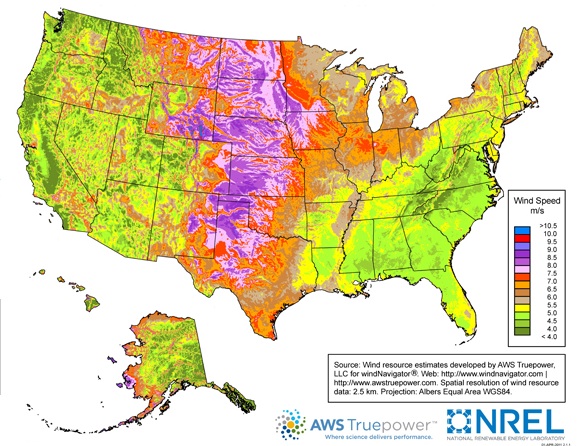
Back in 2007, the output capacity of utility-scale wind turbines in the U.S. was a little over 16,500 megawatts – a tiny fraction of what would be required to meet overall demand, but still enough to make the wind industry a viable, emerging player in electricity generation.
Since then, wind power’s stature as a renewable-energy alternative has continued to grow. By 2016, economies of scale in the manufacture of wind turbines and improvements in their output capacity will reduce the cost of wind-generated electricity by 12% – enough to make wind power competitive with electricity generated by gas-powered turbines, according to a report published this month by Bloomberg New Energy Finance, which specializes in analysis of the clean-energy industry.
Manufacturing costs over the past 27 years have dropped about 7% for every doubling of installed turbine capacity. Global average turbine prices, the BNEF report notes, have shrunk from $27 million per megawatt of capacity in 1984 to $1.85 million in 2011. By the end of this year, there will be an estimated 240 gigawatts of installed capacity worldwide, up from 0.3 gigawatts in 1984.
Bigger, taller assemblies
The increase in output capacity is due to the fact that turbines have been getting bigger and more aerodynamic, and are mounted on taller towers and equipped with gearboxes and controls that combine to produce electricity more efficiently. Per-unit capacity has increased about 13 percentage points since 1984, to 34%, BNEF says.
According to government estimates, average wind load is heavy enough for power generation on only about 6% of the land area in the contiguous United States, so it remains to be seen how big a role wind will eventually play on the grid. But Justin Wu, lead wind analyst at BNEF, says that both wind and photovoltaic technologies are becoming cost-competitive at a rate that will soon make them major players in the energy market.
“In the next few years the mainstream world is going to wake up to wind cheaper than gas, and rooftop solar power cheaper than daytime electricity,” Wu said in a BNEF summary of the study. “Add in the same sort of deep, long-term price drops for power storage, demand management, LED lighting, and so on – and we are clearly talking about a whole new game.”
Fine Homebuilding Recommended Products
Fine Homebuilding receives a commission for items purchased through links on this site, including Amazon Associates and other affiliate advertising programs.

Reliable Crimp Connectors

8067 All-Weather Flashing Tape

Handy Heat Gun

This map shows predicted mean annual wind speeds at a height of 262 ft. (80 meters). Areas with annual average wind speeds of at least 10 mph at that height are generally considered to be suitable potential sites for wind-farm development, according wind data collected by AWS Truepower for windNavigator and reviewed by the National Renewable Energy Laboratory.


























